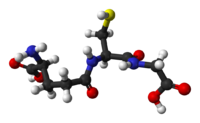
Heat shock induces cross adaptation to aluminum stress through enhancing ascorbate-glutathione cycle in wheat seedlings.
Sign Up to like & getrecommendations! Published in 2021 at "Chemosphere"
DOI: 10.1016/j.chemosphere.2021.130397
Abstract: Aluminum (Al), a neurotoxin agent, is universal in the earth crust, but its bioavailability and toxicity are manifested under acidic conditions. Up to 60% of the acid soils are distributed in tropical and subtropical regions,… read more here.
Keywords: heat shock; wheat; ascorbate glutathione; shock ... See more keywords

Interaction of triacontanol and arsenic on the ascorbate-glutathione cycle and their effects on the ultrastructure in Coriandrum sativum L.
Sign Up to like & getrecommendations! Published in 2017 at "Environmental and Experimental Botany"
DOI: 10.1016/j.envexpbot.2017.07.012
Abstract: Abstract Exogenous application of triacontanol (TRIA) has the ability to mitigate the adverse effects of abiotic stresses by modulating a number of physio-biochemical processes in different plants. However, information about how its effects may be… read more here.
Keywords: tria; triacontanol; ascorbate glutathione; coriandrum sativum ... See more keywords

Enhancing the ascorbate–glutathione cycle reduced fermentation by increasing NAD+ levels during broccoli head storage under controlled atmosphere
Sign Up to like & getrecommendations! Published in 2020 at "Postharvest Biology and Technology"
DOI: 10.1016/j.postharvbio.2020.111169
Abstract: Abstract Broccoli is prone to adopting fermentation under inappropriate conditions, especially high−CO2 atmospheres. In this study, broccoli stalks were soaked in 0.4 % reduced glutathione (GSH) for 3 h, before being maintained in 50 %… read more here.
Keywords: ascorbate glutathione; fermentation; controlled atmosphere; cycle ... See more keywords

Ascorbate glutathione antioxidant system alleviates fly ash stress by modulating growth physiology and biochemical responses in Solanum lycopersicum
Sign Up to like & getrecommendations! Published in 2022 at "Saudi Journal of Biological Sciences"
DOI: 10.1016/j.sjbs.2021.12.013
Abstract: Tomato plants (Solanum lycopersicum L.) were developed in soils with different fly ash (FA) amendments (25, 50, 75, 100% FA) to measure the effects of FA on metal accumulation, chlorophyll pigments, chlorophyll fluorescence, growth, biomass,… read more here.
Keywords: solanum lycopersicum; fly ash; ascorbate glutathione; physiology ... See more keywords

The impact of cadmium stress on the ascorbate-glutathione pathway and ascorbate regeneration in tea plants
Sign Up to like & getrecommendations! Published in 2023 at "Biologia plantarum"
DOI: 10.32615/bp.2023.002
Abstract: Ascorbic acid (AsA) and glutathione (GSH) contribute to defense responses under abiotic stresses. The present study explored the ascorbate-glutathione cycle and ascorbate regeneration under high concentration (30 mM) of cadmium in the tea plant (… read more here.
Keywords: regeneration; day; glutathione; tea ... See more keywords

Endophytic fungus Serendipita indica accelerates ascorbate-glutathione cycle of white clover in response to water stress
Sign Up to like & getrecommendations! Published in 2022 at "Frontiers in Microbiology"
DOI: 10.3389/fmicb.2022.967851
Abstract: Ascorbate-glutathione cycle is an important pathway for plants to scavenge reactive oxygen species (ROS) under environmental stress conditions. The objective of this study was to investigate the effects of the endophytic fungus Serendipita indica on… read more here.
Keywords: stress; water; glutathione cycle; glutathione ... See more keywords

Regulation of Ascorbate-Glutathione Pathway in Mitigating Oxidative Damage in Plants under Abiotic Stress
Sign Up to like & getrecommendations! Published in 2019 at "Antioxidants"
DOI: 10.3390/antiox8090384
Abstract: Reactive oxygen species (ROS) generation is a usual phenomenon in a plant both under a normal and stressed condition. However, under unfavorable or adverse conditions, ROS production exceeds the capacity of the antioxidant defense system.… read more here.
Keywords: abiotic stress; ascorbate glutathione; pathway; asa gsh ... See more keywords

Ascorbate-Glutathione Cycle Genes Families in Euphorbiaceae: Characterization and Evolutionary Analysis
Sign Up to like & getrecommendations! Published in 2022 at "Biology"
DOI: 10.3390/biology12010019
Abstract: Simple Summary The climatic changes pose important threats to agriculture. Plants are sessile organisms and need to cope with different environmental conditions throughout their lifespan. Most responses involve different signaling molecules, including reactive oxygen species… read more here.
Keywords: cycle genes; glutathione cycle; glutathione; ascorbate glutathione ... See more keywords

Sulfur Protects Pakchoi (Brassica chinensis L.) Seedlings against Cadmium Stress by Regulating Ascorbate-Glutathione Metabolism
Sign Up to like & getrecommendations! Published in 2017 at "International Journal of Molecular Sciences"
DOI: 10.3390/ijms18081628
Abstract: Cadmium (Cd) pollution in food chains pose a potential health risk for humans. Sulfur (S) is a significant macronutrient that plays a significant role in the regulation of plant responses to diverse biotic and abiotic… read more here.
Keywords: pakchoi; ascorbate glutathione; cadmium; glutathione metabolism ... See more keywords